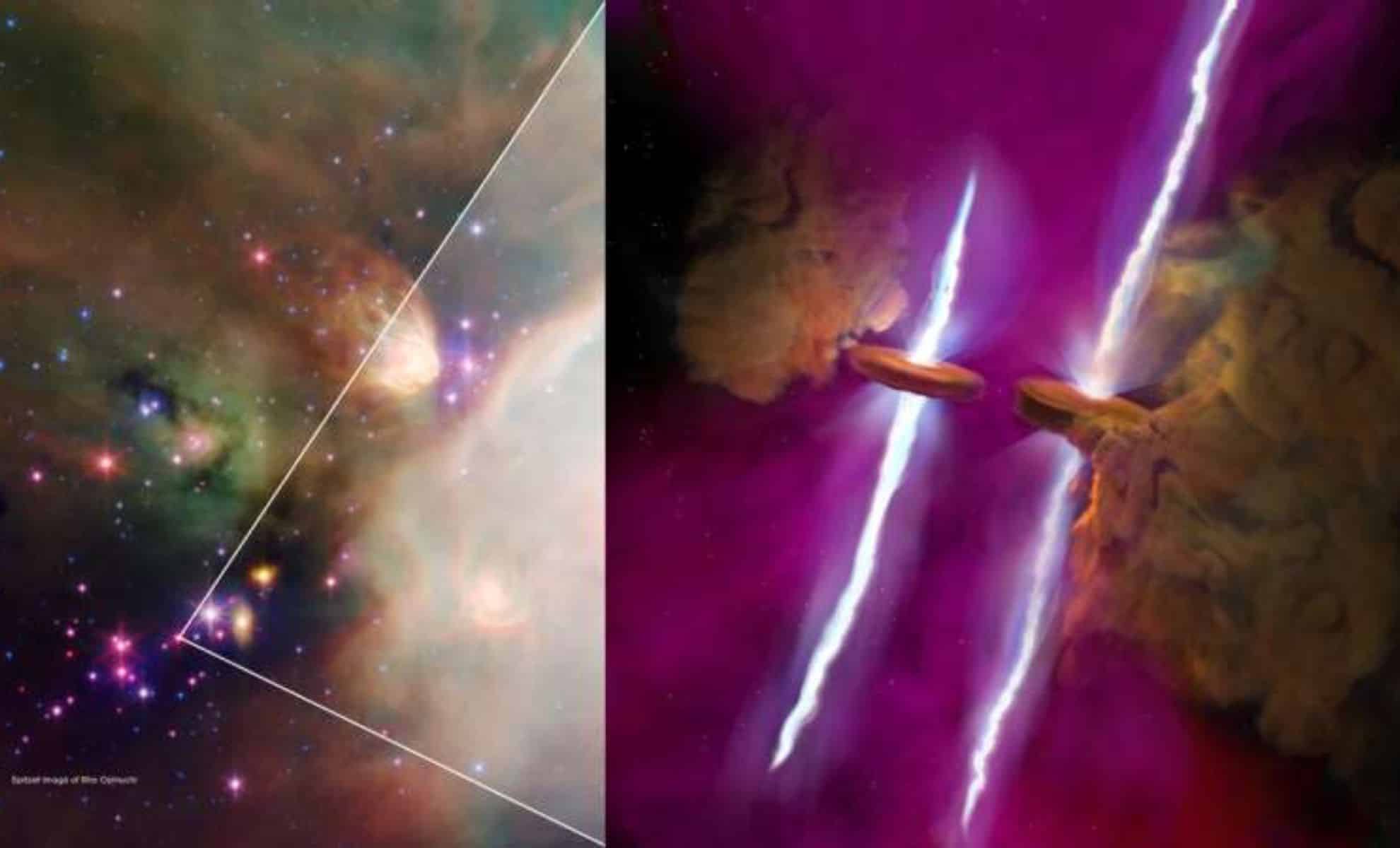Astronomers made the groundbreaking discovery using NASA’s Atacama Large Millimeter/submillimeter Array (ALMA) and the James Webb Space Telescope (JWST).
They observed twin discs and parallel nozzles eruption from a pair of young stars in a star system WL20, located more than 400 light-years away in the rho Ophiuchi molecular cloud complex. This unexpected finding offers new insights into the early stages of star formation and the associated dynamical processes.
A surprising discovery
The discovery, led by astronomer Dr. Mary Barsony, revealed unexpected findings about WL20 star system. At first, one star in the system appeared much younger than the others. However, detailed observations using ALMA and JWST’s Mid-Infrared Instrument (MIRI) showed that this “one” star is actually two stars located close together.
Each of these stars was surrounded by a disk, and each disk emitted jets parallel to the other. Dr. Barsony commented: “What we discovered was absolutely wild. We’ve known about the WL20 star system for a long time. But what caught our attention was that one of the stars in the system looked much younger than the others.”
This discovery was particularly exciting because of the location WL20 in a well-studied region of space. The ability to find such a unique and dynamic system in a known area highlights the importance of using multiple observational techniques. “Using MIRI and ALMA together, we actually saw that this one star is two stars right next to each other,” Barsony explained. “Each of these stars was surrounded by a disk, and each disk emitted jets parallel to the other.
A combination of multiple wavelengths
Combination ALMA and JWST was essential to this discovery. ALMA, which observes at radio wavelengths, detected the discs, while MIRI JWST, operating in the infrared spectrum, identified the jets. This multi-wavelength approach allowed astronomers to reveal details hidden from previous observations. Dr. Barsony emphasized the importance of MIRI in detecting jets, noting, “So if it wasn’t for MIRI, we wouldn’t even know these jets existed, which is amazing.”
Data collected ALMA and JWST has been analyzed in detail to reveal the composition of the discs and the chemical composition of the jets. Valentin JM Le Gouellec of NASA-ARC loaded and reduced ALMA Archival data, while Lukasz Tychoniec of the Leiden Observatory provided high-resolution images of the discs that revealed their massive size, approximately 100 times the distance between Earth and the Sun. Martijn L. van Gelder contributed to the processing of data collected by MIRI and revealed the chemical composition of the jets.
Insights into star formation
High-resolution data from ALMA revealed the structure of disks that are about 100 times the distance between Earth and the Sun. Detailed analysis of these discs and jets provides new insight into the complex processes involved in the formation of multiple star systems. Dr. Barsony explained: “Someone looking at this ALMA data without knowing that there are twin jets would think, oh, it’s a big rim disc with a central hole, instead of two rim discs and two jets. That’s pretty remarkable .”
Findings from this study shed light on the complex processes that govern star birth and evolution in multiple star systems. By observing the twin disks and jets in WL20, astronomers will gain a deeper understanding of how these systems evolve and interact over time. The ability to observe these phenomena in such detail opens up new avenues for research into star formation mechanisms.
Future research and implications
The researchers plan to use ALMA future enhanced capabilities, such as the Wideband Sensitivity Upgrade, to continue exploring the mysteries surrounding the birth of stars and planetary systems. These advances will further improve our understanding of star formation and dynamical interactions within multiple star systems.
Dr. Barsony and her team presented their findings at the 244th meeting of the American Astronomical Society in Madison, Wisconsin, marking a major milestone in the study of young stars and their evolutionary processes.
Colleague Dr. Barsony, JPL scientist Michael Ressler reflected on the serendipitous nature of the discovery. “Much of the binary protostar research focuses on a few nearby star-forming regions. I got my own observing time with JWST and decided to break it up into a few small projects,” he said. “For one project, I decided to study binaries in the Perseus star-forming region. However, I had been studying WL20, which is in the rho Ophiuchus region in almost the opposite part of the sky, for almost 30 years and I thought, ‘Why not sneak it, I’ll never get another chance, even when it doesn’t quite fit the others.” We had a very happy accident with what we found, and the results are astounding.”
By combining multi-wavelength data from ALMA and JWSTThese new findings shed light on the complex processes involved in the formation of multiple star systems. Continued exploration and observation of star systems like WL20 will undoubtedly lead to further discoveries that will enhance our understanding of the universe and the birth of stars.
